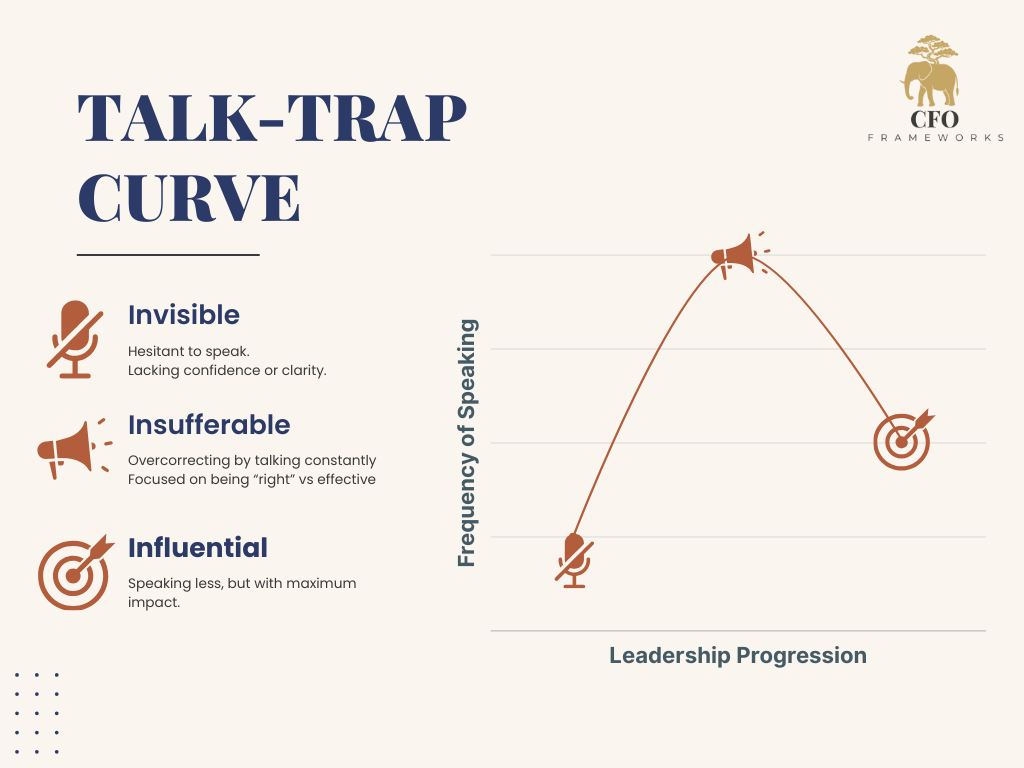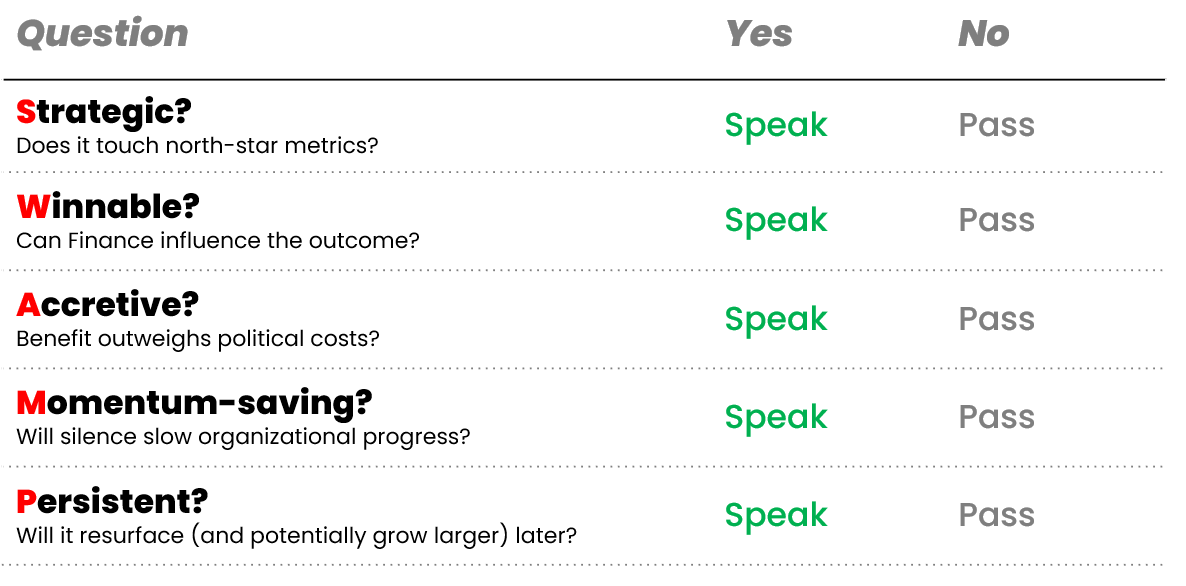WAIT for it
The CFO’s guide to speaking up when it matters...and shutting up when it doesn’t
I finally had it - the mythical seat at the table. Even better, the Senior Director of Operations pulled me aside to encourage me to contribute more.
Your voice is important in that room. We need to hear it more.
Don’t have to tell me twice.
Feeling the rush of relevance, I went into next week’s staff meeting guns ablazing. I was correcting minor revenue differences in real time, critiquing slide formatting, and offering a crash course on what the CFO expected of us whenever anyone inhaled.
Thankfully, that same Ops leader pulled me aside again.
Love the passion, Taylor. Could use fewer…interjections.
Welp, shit.
I suspect I’m not alone in traveling this predictable path. If we’re not careful, we can lose the influence we earn by conflating requests for clarity with commentary.
If we’re not careful, we can talk ourselves out of our job.
The Talk-Trap Curve
Hitting the sweet spot of speaking up enough is tough. At any one time, we can inhabit one of three spots on a Talk-Trap Curve.
Invisible: You stay quiet, hoping the data speaks for you. Inevitably, you get feedback that you are too quiet. If you fail to address this, someone else will take your seat.
Insufferable: You find your voice (and your confidence!) but overshoot, treating every pause or minor difference as an RFP for your opinion. If you fail to address this, someone else will take your seat.
Influential: You choose your battles, time insights perfectly, and raise the room’s business acumen.
The climb from invisible to influential is steep; the slide to insufferable is greased.
Why? Loss aversion. Two of the three spots on the curve are in danger of losing their seat at the table altogether!
We fear losing the trust of the team - missing the one comment that averts financial disaster - so we overcompensate and comment on everything.
To compensate for this, we need to think of our voice as scarce capital. We should deploy it where the Return on Conversation (ROC) is highest.
The Art of Iaido
In the Japanese art of iaido, a swordsman trains to win with one flawless draw-and-cut. Flailing blades are for amateurs; masters make a single motion count. A dojo elder once told his students,
Every extra swing is a confession you planned poorly.
Finance voice works the same way. You can slash at every slide—or stand poised, waiting for the precise moment where one insight ends the debate.
What we need is a framework to help us decide when to speak up vs shut up.
Actually, one may not be enough. Like in iaido, there’s more than on disciplined move you can master.
The three mini-frameworks ahead are your iaido kata: disciplined moves that turn fewer words into bigger wins.
Mini-Framework #1 - WAIT Test
Why Am I Talking?
Before you weigh in, think about what the end-goal is. Ask yourself “Why am I talking?”
Add signal - new data, pattern, or trade-off that should be considered but isn’t.
Protect value - surface a material risk in time to act.
Advance decision - get the group from debate to commit.
If one or more apply, speak up. Otherwise, it’s best to stay on mute.
The filter question:
“Is what I’m about to say worth stepping into the spotlight for?”
Mini-Framework #2 - SWAMP Test
I’m here to cross the swamp, not wrestle every alligator.
It’s tempting to correct the record - to make sure what’s being said or done is right. But the reality is, our value isn’t in what’s right but rather what’s valuable. What moves the ball forward.
Said another way, it’s not worth burning your social capital on minor squabbles.
If you get one or more “yes” answers - grab the mic. If not - holster it. These are the definition of low ROC disputes.
The filter question:
“Will this actually help us cross the swamp - or am I just fighting another gator?”
Mini-Framework #3: The Radio Tower Rule
Assuming you’ve decided not to WAIT and you’re not just wrestling gators, it’s time to decide how to deliver the clarity the team needs from you.
Imagine your message as a radio broadcast. Most finance people transmit way too much data: endless detail, hedged explanations, and multiple caveats.
That’s not communication; that’s noise.
Your real value isn’t your accuracy - it’s your clarity.
Be a signal tower, not a weather station. Deliver one strong, clear message. Stop transmitting when you’ve made your point. Let it land.
When to use it: Once you’ve decided your contribution is necessary, ensure it’s short, memorable, and actionable.
The filter question:
“What’s the single most important thing I want everyone to remember?”
Bonus Framework - Count to Ten
I once attended a forensic accounting training where the instructor dropped this nugget:
People hate silence. When someone stops talking, silently count to ten. More likely than not, the person you’re interviewing will add more color just to fill the silence.
Ten seconds of silence is an eternity in a live discussion. Our instinct, especially when we’re sitting in the Insufferable spot, is to fill that silence with our voice. Don’t.
Count to ten. See if anyone else chimes in. You may learn something new. You may see others step up to challenge the team, saving you the effort.
Embrace the discomfort and let the silence do your talking.
Putting it together
Let’s recap:
💡 WAIT Test: Speak selectively.
🐊 Swamp Test: Don’t chase every detail.
📡 Radio Tower Rule: Deliver clear, concise messages.
🔟 Count to Ten: Give others the opportunity to step in before you do.
Getting to Influential isn’t about talking less - it’s about ensuring what you say gets heard. It’s about knowing your role isn’t measured by how many words you say, but by how much clarity you add.
The CFO’s superpower isn’t their intelligence. It’s their ability to increase everyone else’s.




